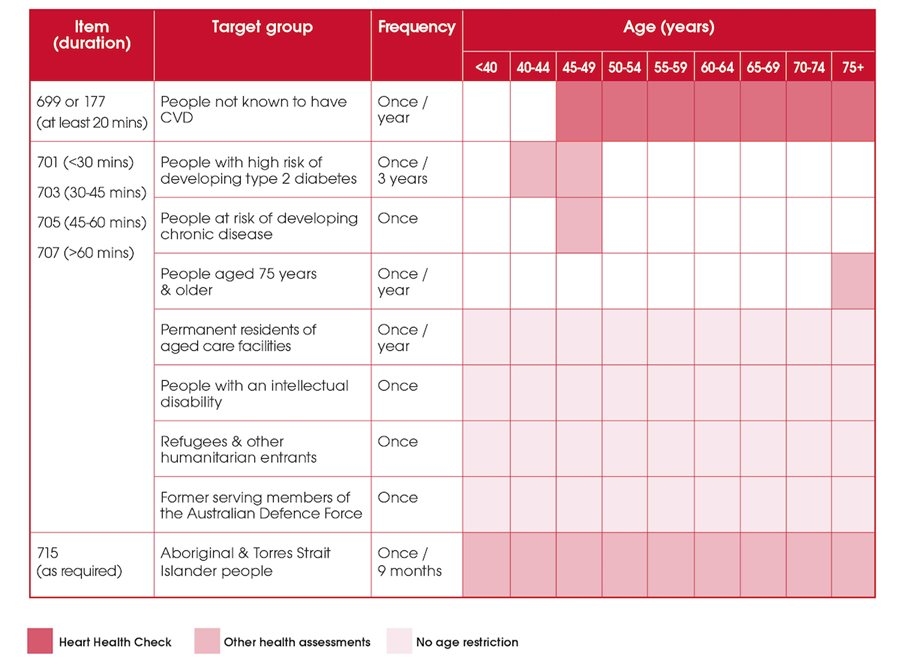
Building a case for the Heart Health Check
Useful concepts to help build your business case to implement the Heart Health Check in your practice
Items 699 and 177 compared to other health assessments
There are several differences between items 699/177 (the Heart Health Check) and other health assessment items:
patients aged 50–74 are now eligible
patients aged 45–74 can now be checked every 12 months.
Further differences in eligibility and claim frequency between the various items are outlined below.

Incorporate the Heart Health Check into RACGP practice accreditation activities
QI 1.1 – Quality improvement activities
C4.1 – Health promotion and preventative care
C7.1 – Content of patient records
C8.1 – Education and training of non-clinical staff
Support staff collaboration and training
recruit team members with different skillsets to help develop ideas and support the implementation of Heart Health Checks
address any knowledge or skills gaps relating to Heart Health Checks and CVD risk assessment and management guidelines
ensure all team members understand the Medicare requirements that must be met before billing item number 699 or 177.
Create a profile of your demographic, health and MBS data
Current data is needed to define your baseline and measure subsequent success in completing Heart Health Checks.
The quality of your clinical data is important in ensuring you accurately target patients eligible for a Heart Health Check.
Identifying and addressing data gaps can help you to set goals to drive quality improvement activities.
TIP: The Heart Foundation has interactive Heart Maps that are scaled to region and local government area.
TIP: Your local Primary Health Network (PHN) representative can assist you with the types of clinical audit tools available (e.g. Pen CAT, POLAR) and their use.
Leverage incentives and existing programs
See the table below comparing the age range and billing timeframes of the Heart Health Check to other health assessment items (e.g. 701–715).
Add routine yearly Heart Health Check reminders to eligible patient records and your practice registers.
Incorporate other incentive programs to add value to your Heart Health Check activities e.g.
the Practice Incentive Program Quality Improvement (PIP QI) measures align with several components of the Heart Health Check. Refer to the QI incentives section
chronic disease management (CDM) items – for patients who have a chronic condition you can co-claim relevant CDM item numbers
consider if patients are also eligible for a medication management review
bulk billing items that can be used include 10990 or 10991 for eligible patients.
use the workforce incentive program (WIP) to increase the support services of your nurses, Aboriginal and Torres Strait Islander health workers, and eligible allied health professionals
seek out relevant locally designed lifestyle programs with your PHN, or via HealthPathways.
TIP: Map the workflow from patient recruitment to claiming and develop a flowchart to demonstrate financial viability.

Toolkit contents
Explore the list of pages in the Heart Health Check Toolkit for health professionals.

About the Toolkit
Supporting general practices to integrate Heart Health Checks into routine patient care, with a range of resources and easy-to-use tools in one place.

Downloadable resources
A full list of ready-to-use resources available in this Toolkit
Last updated21 March 2024
Last reviewed06 March 2024